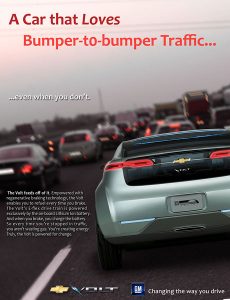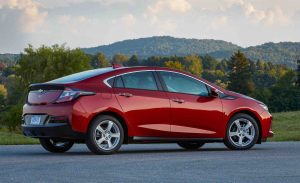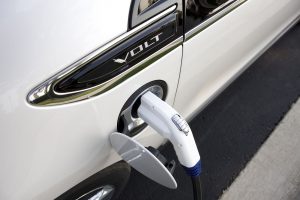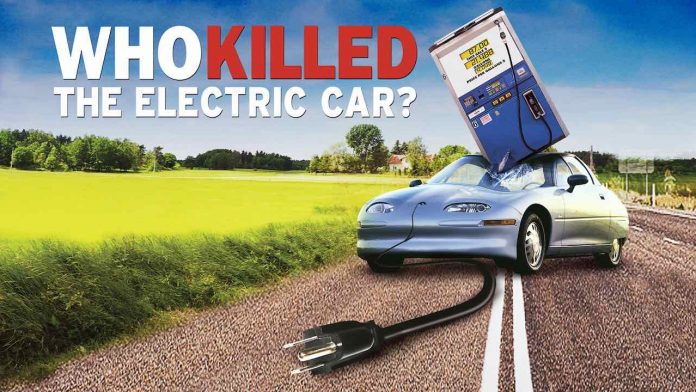Michael Moore did a documentary about Who Killed the Electric Car? – but it was about the wrong car.
It wasn’t the EV1 – also known as the Impact – that was killed by its creator, General Motors. It died naturally, from the same genetic defects – so to speak – that afflict all electric cars to this day. It cost too much money – and it cost too much time. Few people will willingly spend more to get less – and that is what you got with the EV1. It is what you get with all currently available electric cars, which don’t go as far as any other car and take much longer to get going again. They are mobility reducers, which is disincentive enough for most people.
But when you expect them to pay extra for the “privilege” . . .
It was hardly necessary to “kill” that.
Most people simply didn’t want it – or want to pay for it.
Moore should do a video about the Volt.
This was the electric car that GM did kill – via perhaps the most inept marketing campaign ever, which portrayed it as a hybrid rather than the practical electric car it was.
It was a unique ride. A true electric car, propelled by its motors that were powered by its battery pack, with a small gas engine onboard to serve as a carry-it-with-you generator, to keep the electricity flowing, rather than constantly draining.
The genius of this being the elimination of the necessity to stop for a recharge, as the car recharged itself – or could. With the ability to be plugged in when convenient. The last iteration (2019) could go about 50 miles on a charge, without any need for onboard recharging. That was sufficient to encompass most people’s daily commute, or very close to sufficient.
Yet the car could also travel hundreds of miles, too – its range extended by the onboard generator IC engine.
This is similar to the plug-in hybrids that are currently available but also very different. In all other cases, the hybrid’s gas engine serves a primary propulsive purpose – i.e., it functions as a gas (or diesel) engine does in any non-hybrid car. It propels the car, as well as generates electricity to recharge the batteries, which power the electric motors that help to propel the car. 
This is a very important difference – if you are “concerned” about “greenhouse gas emissions” – because it means the hybrid’s gas engine is usually running about half the time – more, if you want rapid acceleration because in a hybrid, the gas engine’s power is used to regularly supplement the available power of the motors, which would otherwise not provide sufficient power to propel the car on their own.
Now, hybrids are a good deal – a much better deal – than electric cars, if you are “concerned” about “the environment.” Their battery packs are smaller, so there’s less environmental damage done extracting and processing the necessary materials, such as lithium, graphite and cobalt. The battery packs last longer, because they are used less often and not as hard. One of the huge technical issues – yet to be overcome – with electric cars is that of the effect of regular deep discharge followed by “fast” charging cycles, which rapidly age a battery and are also an intrinsic fire hazard.
Both are non-issues with hybrids because they do not need to “fast” charge – because you never have to wait for a charge. And because the battery pack is never fully discharged. The onboard governing electronics prevent that from happening by automatically restarting the gas engine to feed electricity back into the battery pack as needed, so that it never becomes fully discharged.
But the Volt was even better than hybrids – in all respects.
Because it could travel 50 miles on electricity, entirely – about 20 miles farther than any currently available plug-in hybrid – and because its gas engine was a generator that only came on when the battery pack’s charge ran low (it was uniquely not connected to the drive wheels and did not directly propel the car, as in all other hybrids) it burned almost no gas during most drives – thereby emitting almost none.
Owners will attest to the need to use fuel stabilizer because a full tank in a Volt will sometimes last for months.
This is so because the car’s 50 mile all-electric range is sufficient to encompass most people’s daily drive – or most of it. Even if the car’s all-electric range is exceeded by say another 30-40 miles, that amounts to the burning of perhaps 1 gallon of gas – to travel a total of 75-80 miles. It takes a long time to consume the 9 gallons of gas the Volt carried in its tank at that rate.
If half the cars on the road were Volts or cars like the Volt, “greenhouse gas emissions” would plummet – and not just because of the fact that cars like the Volt hardly emit any gasses. Millions of people could afford to drive a car like the Volt, which cost about what a plug-in Prius costs (just under $34,000 in 2019).
And which did not cost them the wait.
Or the risk.
As opposed to what a Tesla3 – the least costly model costs ($41,190 to start).
Or a Bolt – the most affordable electric car GM currently sells ($36,500) and which GM just had to recall all of because of fire risk associated with “fast” charging – the same issue plaguing Teslas. The same issue that plagues all electric cars that have to “fast” charge to try to overcome or at least partially palliate their primary functional gimps – their short range and extended recharge times.
Those are the other costs of electric cars – which account for the need to force them onto the market and force people to accept paying more for less (as well as placing them in danger of a hideous death via spontaneous combustion).
The Volt came with no such costs. It wasn’t dangerous – to its owner or “the environment.” It was affordable and it was practical. It did not require a completely new, hugely impractical and titanically expensive network of “fast” chargers to make it viable – and which will require god-knows-how-much in the way of “environmental” costs associated with erecting this new infrastructure – and to summon the necessary generating capacity to make it work.
Which it still won’t – unless you don’t mind having to stop every 150-200 miles or less to wait for 30-45 minutes or more. And remember to avoid parking it in the garage – so as to avoid burning down your house.
If the “environmentalists” were truly motivated by “concern” over “greenhouse gas emissions” from vehicles, a car like the Volt would have been cheered – and more such encouraged.
Instead, the Volt was misrepresented – and even castigated, on account of the fact of its still having a gas engine, no matter how little gas it burned or emitted. This castigation being religious and political rather than rational. If what is wanted is a car that is environmentally friendly without reducing mobility or decreasing affordability.
GM deserves heaps of blame for not properly explaining – or defending – the Volt. But its tarring-and-feathering by the “environmental community” speaks volumes about what this bunch is truly “concerned” about.
Michael Moore might do a movie about it.
. . .
Got a question about cars, Libertarian politics – or anything else? Click on the “ask Eric” link and send ’em in! Or email me at EPeters952@yahoo.com if the @!** “ask Eric” button doesn’t work!
If you like what you’ve found here please consider supporting EPautos.
We depend on you to keep the wheels turning!
Our donate button is here.
If you prefer not to use PayPal, our mailing address is:
EPautos
721 Hummingbird Lane SE
Copper Hill, VA 24079
PS: Get an EPautos magnet or sticker or coaster in return for a $20 or more one-time donation or a $10 or more monthly recurring donation. (Please be sure to tell us you want a magnet or sticker or coaster – and also, provide an address, so we know where to mail the thing!)
My eBook about car buying (new and used) is also available for your favorite price – free! Click here. If that fails, email me at EPeters952@yahoo.com and I will send you a copy directly!












Who Killed the Electric Car? > https://en.wikipedia.org/wiki/Chris_Paine#Filmography
Yeah, I didn’t think that was a Michael Moore joint.
Had a good laugh yesterday. I snapped a pic at a gas station in SC just before the GA line of a NYer getting a quick charge at the row of Tesla chargers. Only Tesla there. I pulled up to the pump, started the pump, and then strolled further out to take the ultimate electric car pic….. A lone Tesla at a bank of chargers, with my caption saying, “guess what else charges faster than a Tesla?” with the refueling truck for the gas station in the background. I think the driver must have noticed I was poking fun at him and left shortly after. I supposed he figured I was making fun of him the way he likely makes fun of Southerners or that Japanese tourists want to take a picture of the fattest American they can find while here on vacation.
The reason that there’s such a big push for people to drive electric cars is that an electronic geo-fence wouldn’t work on a gasoline-powered car. In a few years, your electric car will be guided by a government-controlled GPS, with limits on where each person may go.
The intent of all this is to create a “civil-rights” black-only area of the country. And perhaps of each city. So if you’re white, the car will refuse to take you to that area. Once these “black only” areas have been established, they’ll grow to encompass entire regions. And since Washington decides who is allowed to go to those areas, it will be impossible for anyone to see what’s happening.
Blacks want a national homeland, and they intend to get one. With electric cars.
Interesting. I watched a GE Griffin video from ‘69 posted on LRC the other day and in it he said something similar about black “homelands” being part of the plan for the communist takeover of the US. Worth watching. About 15% anachronism, the rest right on point today.
“Instead, the Volt was misrepresented – and even castigated, on account of the fact of its ” limited drain on the existing grid. The entire point of EV is NOT to burn less gas and get there greener, the point is to create a market for nuclear SMR’s and LFTR’s from China.
Currently, there is NO market for a new small modular, or Liquid Fluoride Thorium reactor anywhere. Because there is an existing plant there that is generating all the power we need at an affordable price. They MUST create more demand if they are to sell new generation. NRC has approved the Chinese reactors – they are running NOW, and can be shipped in containers and turned on the next day.
Any news about how electric cars do in emergencies? With the big fires on the west coast, hurricanes on the southeast coasts and floods or snow storms everywhere else, it seems that having a gasoline/diesel vehicle is the only way to get through or away from such disasters. And how many fires were caused by evs that pulled over or crashed and caught fire? Seems that the pollution caused by some ice vehicles is less than burning 40 million trees.
Also many wildfires happened back in the 70s & 80s cause catayletic converters torched dry grass when people pulled over or drove off road. Probably still happens cause cars are too complicated & expensive for average people to maintain.
Its unbelievably stupid how many environmental disasters are caused by rushing to implement technology to save us from disaster.
Anyways i believe in climate change so I have a gas powered air conditioned awd car to keep me comfy & safe.
I think Eric’s point here, is that the BEST design for an electric car is Battery + motors + generator. A gas turbine generator that can run the motors when the batteries die. With an EV built like that, Emergency Schmergency. Just keep some gas around. You could use a car like that to keep your AC and refrigerator working in an emergency, because you basically have a generator on wheels.
Gadzooks! Seems like the perfect ‘transition’ vehicle to me. From a time where hydrocarbon fuels dominate to one where electric vehicles might, and no loss of love (at least on my part) due to the lack of a ‘Woke’ badge, such as the Prius seems to have. No wonder it’s life got crushed out of existence.
Jeremy
This is another of the articles by Dr. Lee Merrit.
It is on Lew’s site today 8-30-21.
She is one of the three I told you about a few days ago.
I did go back and put info up for you regarding those other articles you ask for.
rog
Hi rog,
Thanks for the tip, I’ll check it out. And thanks for the previous info as well.
Cheers,
Jeremy
Your article makes sense. The Volt was GM’s greatest achievement, ahead of its time, and a practical solution to range anxiety. My 2013 Volt is averaging 139 MPG liftme, and still gettng about 40 MPC, with no degradation in battery over 8 years. I got the car for about $28k, plus taxes, using GM discounts and a GM card rebate, on a $42k MSRP vehicle. I change oil about every 25k miles, with very little maintenance otherwise, and need about 7 gallons of gas per month. I certainly do not miss going to the gas station often; it is a very dangerous place. I figure my Volt has saved me over $5k in gas and maintenance so far, with bulletproof reliability and 5-star safety. The original brake pads are hardly worn due to regeneration. The hatchback makes it a very capable hauler. It is incredibly smooth and quiet in operation, and the transition to gas is seamless. I rarely need to charge outside of home, conveniently done overnight with a normal 120v outlet and supplied charger. I do have the 240v option, which takes about 3.5 hours to give me 40 more miles of EV travel. It’s a pretty good looker, as well. Yes, it is a shame that GM did not properly promote this practical solution.
I bought my Focus a year later for half that price. Maybe in another 10 years I’ll make up the $14k difference in price.
Amen, Johnny…
Note the common denominator: That which works, which makes sense, which people can actually afford, which improves their standard of living and gives them more freedom… is systematically discouraged if not outright forbidden. But that which makes their lives more onerous and expensive, which gives government and corporations more control over their lives… is forced down their throats like feed to a pate de foi gras goose.
An EV with a generator, does not FORCE us to upgrade our grid with Chinese reactors.
Again a great piece Eric. My biggest complaint is you are too kind to the EV crowd on real world performance. Have talked with and observed several owners, to include Tesla owners. 80 miles or a little less seems to be the max if you drive like a gas car. 70 plus on the interstate is rarely done unless you want to die at the side of the road before you get to your destination. Also have heard that performance drops both as the batteries get low and as they age. Their brag of free fuel from the charging stations available in our area (Bass Pro and a couple Hotels) are a scam. The tax payers are paying for that mess via grants to business. We run 300 plus miles a day with our business and travel some less than desirable territory hauling major loads. The EV is not even a thought for us, yet we are literally hearing it is going to forced on us. As you said, the short urban commuter hauling his ass to work and back, the Volt or even an EV can work. Let those people buy them. Leave the rest of us alone.
Good friend of mine has a VOlt like the one described. He is a very brainey ingineer, sort of an enviro-creep, but has his head on straight. In response to my early disdain for his choice of ride, he calmluy explained to me the difference between t his Volt and all the’ Other” envoio-cars. He has taken some ong trips (mulit-thousand mile ones) and on those his real0tie average return on fuel sits solidly at 42 MPG. Imprssive in tday’s car market. i think he paid a bit north of $30K for it, maybe a tad less, but got tax incentives from our disgusting state gummit dweebs, which sogtened that blow somewhat. I’ve ridden in the car, it feels pretty good for a car in that class. Far roomier than the Prius.
Then I told him about my favourite cars from days gone by (we are about the same age0. I’ve had, and workd on for others, quite a umber of the older REAL VOlvo cars, Swedish made, ranging from late 1950’s up through 1971, when thye switched from the astoundingly wonederful SU Cerburetters from England, to Bosck L Jetronic fuel feed. The carburetted engines, when propery tuned, consistengly will cruise at 85 mph all day long, comfortably, and return 42 miles per gallon of the chepea If even marignally cared for, they will tyoucally have a life expcectancy of 150 50 300K miles, then we worthy of an engine rebuild. Back when I had them one could typically be had, perhaos atad on the rought isde of things, but fully funcitonal and solid, for a few hundred dollars, at most just above a grand. Wich I had one today… a 1222 wagon with overdrive and the orignal engine bored over to 2 litre displacement. Just thinnk.. for the price of a Volt I could have filled an entierr stable with them, driving one until it gives up like the legendary WOnderful One Horse Shay….. sigh. Thos times are long past. Still can’t afford a Volt, though. st fuel yuo can find.
Now, imagine a Volt, in a world where “authority” had not killed compression ignition engines. A Volt diesel, combining the fuel efficiency, longevity and fuel stability of a diesel ICE for onboard power generation. A consistent 100 mpg would not be out of the question at all. VW was working on a similar prototype years ago that they claimed was good for 200 mpg.
But of course, all of that is now verboten.
Rest assured, our oppressors will continue to tool around in ten ton armored tax tractors getting 4 mpg until the whole mess collapses.
Not for us Mundanes though. The ruling class has hated cars, and freedom of mobility, for the masses since Henry’s first Model T rolled off the line.
They are getting just what they wanted.
We’ll be lucky if they “allow” us a Chairman Mao bicycle.
oh they WILL indeed permit us to USE (not necessarily own, you see…) bicycles.. PROVIDED they are fitted with onborad electronc geo-locator technology. Can’t have us knocing about on our own, unaccounted for, now, can they?
And your idea of a small diesel engine.. something like the ancient and venerable Perkins 4/107 used as mid sized salboat auxilliary powerplants. Those things would put for hours and the fuel they consumed would need to be measured by the mililitre per hour. Kubota and similar three cylinder are in the same category.
If the “environmentalists” were truly motivated by “concern” over “greenhouse gas emissions”
How come no one ever talks about the “emissions” from ‘our’ imperial forces scattered about the globe?
Left out of the story is GM is out in front with hydrogen cars. I have a hunch that once the states realize they can sweep aside all privacy to track cars and bill by the mile because hydrogen cars will not be stoping at gas stations, hydrogen cars may go mainstream. But I’m going to stick with my IC motor power cars and trucks to the bitter end.
Hi Mark,
I’m hugely skeptical of hydrogen powered cars because of the cost involved. Consider the Toyota Mirai. Base price? Almost $51k. For a car that is – other than its hydrogen fuel cell/electric drivetrain – essentially a Camry type sedan. And a Camry cost about half as much. Are people going to willingly pay twice or even a third or a fourth more to buy a car? Where will they get the income to compensate for this additional expense?
It can be regarded as a massive tax increase on the American driver – because that’s what it effectively is.
The cost like any cost can come down with more production. I’m not a fan of any kind of car or truck but for IC engines. However, electric cars will never come to being in large or massive numbers because the limited resources to make batteries. It’s nothing more that a pipe dream. I agree, the best deal on any car is an IC engine. But the Green New World Gangsters want the IC to go so it’s going to be interesting to see what transpires in the coming years. But one thing for sure, government’s hunger for more ways to take more money out of the family budget for themselves will bring in a scam of tax by the mile and you better not go over your allocated miles because it’s going to cost a whole lot more money per mile.
I think, this says that we would use up all the water on the earth if we switch to Hydrogen: https://phys.org/news/2007-10-analysis-requirements-hydrogen-economy.html
That’s all fine and dandy…except that the entire “everyone must drive an EV” proclamation is based on propaganda and outright lies. The premise is the fake global warming crusade, now about 4 decades old.
It’s the same with “injecting” the world’s population with mRNA poisons purely based on the assumption that we should fear dying from CoV-2 or some variant, while there has never been one smidgen of virus ever produced by anyone.
By the way, these two monsters of nonsense are interconnected. In order to save the planet from global warming, fake vaccines that murder healthy people must be used to reduce the “pollutants”…those are mainly people.
The Volt is a series hybrid with a battery. It is much like the locomotives GM Electromotive have made since the 1930s. Those diesel engines in those things do not turn the wheels. They create electricity for the electric motors to turn the wheels. No batteries though.
Anyway the Volt simply is not suitable for the agenda. Because it is the sort of vehicle that could actually be a proper EV with no compromises to the user. It works exactly as they expect an automobile to work, just with a lot fewer gasoline stops in normal use. Although with 9 gallon tank it might have about normal stops every 300mi or so.
on long trips. missed that last part.
Eric,
You know what would be interesting? A reprise of the EV-1 with modern tech. I understand that the original prototype was done with ancient lead-acid batteries-freakin’ lead-acid! They later used NiMH. It would be cool to see what the EV-1/impact could do with Li-Ion batteries, modern computers, and modern motors. I bet that, with its goo aerodynamics, that the EV-1 could easily do 300 miles at highway speeds.
As for battery fires, it’s not necessarily fast charging that causes it. Number one, homes can’t be wired for it; the most a home can be wired for is Level 2, or 240 VAC. Two, I’ve never heard of any Tesla going up at a Supercharger. Three, they often go up while on the road or even PARKED! It might be due more to the battery chemistry itself. It could also be manufacturing defects, where something is shorted; this creates high current, which creates thermal runaway, which starts the fire.
What would be interesting to find out is if it’s cell type? AFAIK, the Telsa fires were all in Model S or X vehicles, while I’ve never heard of a Model 3 or Model Y going up in flames. The S/X use 18650 type cells, while the 3/Y use 2170s. As a result, the packs are different too. A Tesla Model 3 or Y may have gone up, but I’m not aware of it. It would be good to do a study on this. Why does the S/X go up, while the 3/Y doesn’t?
I’m curious about the Chevy Bolt. I’m aware of its recalls. Is it cell type? Is it manufacturing defects? Why does it go up? Why is it being recalled again?
As for the Chevy Volt, I’ve thought about getting one. Now that I’m retired, I don’t drive that much; the 50 miles of electric only operation would be more than enough for 90%-95% of my daily needs. When I take the occasional road trip, the onboard ICE generator would be nice to have. I could then recharge where I stay, do EV operation where I am, then use the onboard generator for the return trip. I wish the Volt were still made!
BMW used to make a similar vehicle; I believe it was the i3. The i3 was the same size and general look of the Scion IQ. It could be purchased as a BEV or a PHEV. The PHEV had a 650cc, 2 cylinder engine that BMW called a range extender. But yeah, vehicles like the Volt are rare, and they shouldn’t be.
Those are my thoughts…
Tesla superchargers only charge to 80% and then they slow as they must. Since few people hang around at some supercharger for the long slow slog of getting the last 20% in it may be why there are less fires. They charge to 80% and get back on the road, discharging. Coolant system working, air rushing by, etc.
I would think that the home charger on 240V would be fast enough to risk fire if something went sideways provided it can access enough current. To bring the fire risk down to trivial it will be reducing it something akin to charging your phone via USB port on your computer. Very very slowly.
Anyway fire is a possibility on discharge and charge. It will always be in the details if does or doesn’t. Just sitting there is either a defective cell or physical damage.
Hi Eric,
I acquired a 2012 Prius from my mom when she decided she could no longer safely drive. It became my wife’s daily driver, but she hated the car. After 3 years of a passive aggressive campaign of poor driving inflicted upon the vehicle by my wife, I decided to unload the Prius before she completed her mission of slow motion destruction. Due initially to your review of the 2nd gen Volt, I became obsessed with the car. I have a covered, wired carport at my house, rarely drive more than 20 miles a day and wanted a car (not a truck) capable of long trips. The Volt is perfect. It easily charges overnight on 120, no special equipment required and I rarely exceed the all electric range (if I do, it doesn’t matter).
Fortunately for me, the Prius is overvalued in people’s minds, and the Volt is undervalued. While visiting my sister in Texas, I traded in the beat 2012 Prius for a pristine 2013 Volt. I got $6,000 for the Prius, the Volt was priced at $6950, $950.00 out of pocket and I drove back to SF in my new car. Initially I was interested because the idea seemed brilliant to me and the convenience of plugging the car in rather than filling it up was attractive. What I didn’t expect is how much fun it is to drive. The Prius was awful, stupid toggle switch instead of a shifter, very sluggish, the annoying noise/feel of the CVT and constantly beeping at you if you ignore any of the safety “advice”.
The Volt is a vastly superior car. It has a normal automatic stick shifter, so there is some tactile connection. It has park, neutral, reverse, drive and low, just like regular automatics. But the L position engages regeneration and, when engaged, it feels just like downshifting. It’s fun to approach tight corners, “downshift” to scrub a little speed, shift back to drive and then accelerate out of the corner. It almost feels like your driving an ICE with a manual transmission. Of course it’s not a speed demon, but it feels very quick and handles well. Except for the terrible visibility, which seems to plague most modern cars, it is a spectacular car. If the scamdemic had not driven used car prices through the roof, I’d be looking for a deal on a gen 2 version.
Cheers,
Jeremy
I could probably live with a Volt. I could live with a Prius. Not so most of the other electric options out there.
Hi Publius,
Of all the annoying things about the Prius, the most trivial eventually became the most intolerable. The car loudly beeps at you every time you put it in reverse. At first I thought it was a “safety” feature for other people, outside of the car. But no, it cannot be heard outside of the car. It’s screaming only at you, reminding you, for safety, that YOU have just put the car in reverse. Ironically, the sound is so grating, to me a least, that I would reverse as quickly as possible just to make the horrible sound go away. I couldn’t find any hack to make it stop. I read somewhere that you could do something to make it only beep three times, but I got rid of the car so it didn’t matter anymore.
Cheers,
Jeremy
What year was yours?
My dad has one, an 09 with one of the extra trim packages. I can’t remember if his does that or not, though.
He also has a ’14 Insight. He likes both cars. Not my cup of tea exactly, but I drove the Honda once and it was fun. Doesn’t go super fast, but it is fun. I don’t think I’ll get to drive it again, though, because I took it around an on ramp hard enough to chirp the tires.
Hi Publius,
My Prius was a 2012, my Volt is a 2013.
Cheers
Hi Eric, I believe the combustion motor does assist propulsion at highway speeds via the planetary gear. https://www.gm-volt.com/attachments/voltec_drive_unit-pdf.74706 I do not think this affects the gist of your story though.
IIRC, GM (the company) grudgingly built this vehicle. Bob Lutz wanted it. A big segment of the public went nuts over the concept car and started a social media campaign. GM bean counters have a long memory, and the EV-1 debacle was still fresh in their mind.
The California air resources board has stricter rules for battery pack warranties then the rest of the universe, so the Volt wasn’t able to be driven in HOV lanes, according to Wikipedia. Later Chevy changed the classification that would allow it in HOV lanes, but imagine trying to explain to a DMV employee that “no, this year’s model is a different classification, so it gets a sticker.”
I also think it was one of those “We lose money on every sale but make it up in volume” situations for GM, because the battery cost didn’t fall as quickly as they projected. Some claim they bought a battery manufacturer to shut it down, but I think they discovered the company’s “game changing” manufacturing techniques were about as real as Theranos’ blood testing devices.
The dealers didn’t like them because there was a radically different skillset needed to sell and service the darn things. Better have insulated tools too. The greens didn’t like them because GM killed the EV-1 and they all saw that documentary and we all know that GM at the time was just a bunch of evil doodie-head white men, while Toyota was groovy and Japanese and the Prius looks stupid.
My dream car would be a modern build of the Chrysler turbine mated to a generator feeding power into an all-wheel direct drive system. Battery for acceleration short distance, and to run the campsite. Put it on a Ford F250 chassis with airbag suspension for extra clearance when off-road. All that electric motor torque at the wheel, individually controlled. Just throw on an Arctic Fox camper and you’re all set for the bug-out.
Virtually all government laws, edicts, and regulations, from a license for your barber to driving IC cars off the road, serve no one but the business they are protecting from competition. The business of government is CREATING monopolies, not breaking them up.
“If the “environmentalists” were truly motivated by “concern” over “greenhouse gas emissions” from vehicles” – they aren’t
They are concerned about govt rent seeking.
There is a huge industry around “green” energy, and this is a case where follow the money shows the real interests at play
They produce nothing we want at a price we want to pay, so they take your tax dollars